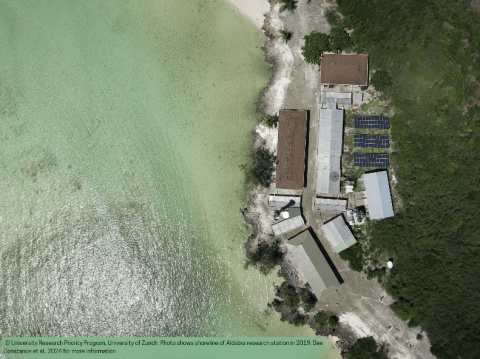
Despite sea level rise in Western Indian Ocean, more than 60% of Aldabra Atoll's shoreline remained unchanged from 1960 to 2011, based on aerial and satellite image analysis. On average, the shoreline changed at a rate of 0.25 ± 0.36 meters per year, with significant localized erosion trends. The international team led by University of Zurich and Seychelles Islands Foundation researchers highlighted Aldabra Atoll's resilience and its ability to maintain its shoreline despite the threats to reef island processes. They emphasized the key role of non-climate factors, such as sediment supply in driving changes to the shoreline. Additionally, they stressed the importance of long-term monitoring and the critical role of Aldabra's protection status in preserving its natural dynamics.
Low-lying islands are threatened by sea level rise due to global warming. Between 1993 and 2013, coastal areas within the Western Indian Ocean experienced a sea level rise of 2-3 mm per year. Understanding how this rise affects the shoreline of Aldabra Atoll, a UNESCO World Heritage Site in Seychelles, is crucial for the management and protection of its unique ecosystem and species.
Aldabra’s shoreline is dynamic but does not show major loss overall
A new study led by scientists from the University of Zurich and the Seychelles Islands Foundation has illuminated the dynamic yet stable nature of Aldabra Atoll's shoreline. Recently published in Scientific Reports—Nature, this research tracked shoreline changes for 51 years using aerial and satellite images, providing the first comprehensive understanding of shoreline responses on raised atolls.
Despite rising sea levels and reduced sediment supply, Aldabra Atoll has successfully maintained its net shoreline and likely total land area. Findings show that 61% of the shoreline remained unchanged, while the areas that did change averaged approximately 25 cm per year—lower than the global average for atolls. The lagoon shoreline underwent more rapid changes than the erosion-resistant ocean shoreline, particularly in areas exposed to wind and waves.
Local shoreline changes and effects on ecosystems
While the shoreline on average, has not changed, the study observed local accretion and erosion affecting 24% of the total shoreline (12% of the shoreline accreted and 12% eroded). For example, accretion happened on the lagoon shoreline, shifting sandy beaches to mangrove habitats. On the other hand, erosion affected sandy beaches with turtle nesting sites and the research station.
Leaving islands and their surroundings undisturbed is importance for their resilience
Annabelle Constance, the lead author, stated, "Our findings are significant as they highlight Aldabra Atoll's resilience and its ability to maintain its shoreline despite rising sea levels and climate change." She further emphasized, "Our research enhances understanding of reef island adjustment capacities in raised atolls and provides a benchmark for shoreline change rates for atolls, given the minimal human impact on Aldabra."
However, continuous monitoring and timely adaptation strategies remain crucial for the conservation of Aldabra's unique ecosystems, particularly as extreme events and the impacts of climate change are predicted to worsen.
"Translating our findings into a broader context highlights the importance of minimizing local human impacts on the coastline, particularly regarding sediment availability, to preserve the natural dynamics of reef islands." She said.
"We were very lucky to have access to airborne imagery that was available from the 1960’s, providing a unique reference in time" says Gabriela Schaepman-Strub. "But we should not forget – this imagery was acquired when Aldabra was threatened by development plans back then." The plans were eventually stopped and Aldabra became a UNESCO World Heritage and Ramsar Wetland Site.
Schaepman-Strub adds "And as we understand now from our study, the resilience of Aldabra's shoreline to sea level rise might be tightly linked to its high protection status. If humans start to disturb this system, for example by building tourism infrastructure into the sea or on land, this might strongly impact the natural erosion and accretion mechanisms, reducing the resilience to sea level rise."
The full paper is open access and available through this link: Low average shoreline change rate in 51 years on the raised Aldabra Atoll | Scientific Reports
Full reference: Annabelle Constance et al. Low average shoreline change rate in 51 years on the raised Aldabra Atoll. Sci Rep 14, 28970 (2024).






